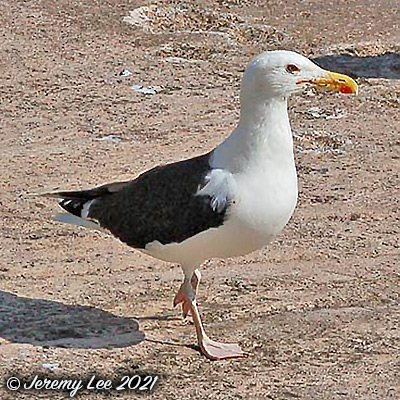
 |
|
Scientific Classifications explained » Amphibians » Ants » Aphids » Bees » Beetles » Birds » Bugs » Butterflies » Caterpillars » Damselflies » Dragonflies » Earwigs » Flies » Frog/Leafhoppers » Fungi » Galls » Grasshoppers » Harvestmen » Hoverflies » Lacewings » Ladybirds » Leaf Mines » Lichens » Mammals » Millipedes » Mosses » Moths » Sawflies » Slugs » Snails » Spiders » Trees & Shrubs » Wasps » Wild Flowers » Woodlice » Postboxes |
UK Nature > Birds > Larus marinus

Scientific Name: Larus marinus Common Name: Great Black-backed Gull Larus marinus, more commonly known as the Great Black-backed Gull, is the largest member of the gull family, measuring 64 - 79 cm in length. It possesses a powerful beak and will fight off other gulls and chase them to snatch food. Adult birds are noticeably blacker than the smaller Lesser Black-backed Gull (Larus fuscus) and have pink legs as opposed to the yellow of the latter. It has a heavy flight and can look quite hunched when perched. Commonly found around the coasts in the breeding season. At other times of year it can be found wherever gulls congregate, at reservoir roosts, rubbish tips inland, bays and harbours. They are present all year round; found inland mostly in winter, their diet consisting of shellfish, birds and carrion. |
|

https://www.uknature.co.uk is a website dedicated to showing the immense diversity of UK nature and wildlife. Our vast range of habitats, from lowland arable to snow covered mountains, from storm-ravaged coastlines to peaceful inland freshwater lakes and rivers, from dry, sandy heaths to deciduous and coniferous forests, all these habitats contribute to the abundance of UK nature. We have wild birds in huge numbers either residing or visiting our shores (597 recorded species as at July 2013) and we must also not forget the humble back garden with its grass lawns, flower beds filled with nectar rich flowers, shrubs and trees, all designed to attract huge numbers of insects such as bees, moths, butterflies and hoverflies; and finally the small ponds which provide safe havens for frogs, toads, newts and even slow worms and grass snakes. www.uknature.co.uk is the showcase for my personal passion, photographing uknature in all its glory. I sincerely hope you all enjoy the fruits of my labours. This site and all images contained therein is © Jeremy Lee 2004 - 2025. All Rights Reserved. Site design by Jeremy Lee. Site development & IT Support by Stuart Lee. |